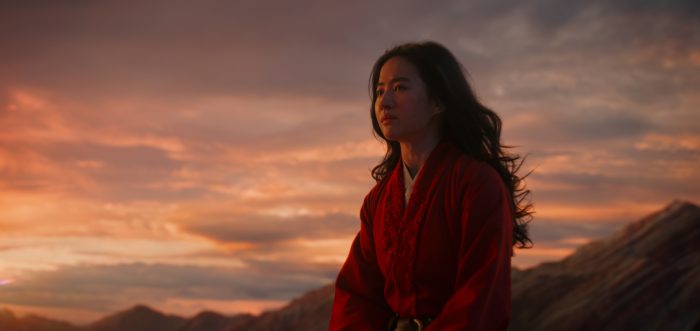
It was an iconic scene in Walt Disney Animation’s 1998 film Mulan: in despair that her injured father was going to be sent off to likely die in war, Mulan weeps underneath a giant stone dragon statue, uncaring that she’s caught in a downpour. Suddenly, as Jerry Goldsmith‘s intense score swells to a crescendo, Mulan looks up with a steely resolve. The montage is epic and frightful, Mulan heading first to her ancestral shrine to light an incense stick then to her sleeping parents’ room to leave her comb. Then she descends on her father’s armory, unsheathing his sword and — flinching for a second — using it to cut her long hair.
It’s a strong, impactful scene that is still remembered today as a formative feminist moment for audiences who grew up watching it. But it’s nowhere to be seen in Disney’s upcoming live-action remake of Mulan.
Fans noticed right away that Mulan was rocking long tresses in the trailers for Niki Caro‘s live-action remake. But there’s a reason that Liu Yifei has long hair in Mulan, and it’s more than just that it looks super cool when she fights. In /Film’s visit to the set of Mulan, producer Jason Reed and costume designer Bina Daigeler explained that Mulan’s long hair in the live-action remake is more historically accurate. Reed, who in our set visit report revealed that when Chinese audiences first saw the hair-cutting scene in 1998, they “mocked” the film, said:
“In the Disney film, the scene where she’s cutting her hair off, it’s actually an anachronism. So Chinese warriors, male warriors wore their hair long. Chinese men wore their hair long. For her to cut her hair off, it would make her look more like a woman than less like a woman in reality. Since we’re doing the live action version, because we’re looking at the world wide market we thought we had to bring that level of cultural accuracy to it.”
Cutting her hair was very much a Western insertion, with short hair — especially in the ’90s with its grrrl power movement — symbolizing an empowered, feminist shedding of social expectations for women. But in the context of ancient China, where both men and women wore their hair long, it made no sense. So how does the live-action Mulan maintain that same sense of empowerment without resorting to feminist gestures? By allowing Mulan to (literally) let her hair down and embrace both her feminine and masculine sides of her identity.
“We refer this to her ‘warrior princess’ look,” Reed said of Mulan’s appearance in the final battle, when she wears her hair loose and fights in only her red under tunic and some armor on her hips that make a sort of skirt-like structure. Reed added:
“When we first see her early in the film, as a simple village girl, her hair is back but down (in a ponytail). She’s very traditional. When she goes in the army she has to wear her hair up in a top knot like all the men do so she blends in and looks like everybody else. And then before she comes into this scene, she realizes that in order to help her comrades and fulfill her duty that she needs to be true to herself as well and in part of that is, as we visualize it exactly, her hair comes down, it’s flowing in the wind, she’s totally kick ass. And that’s how we try to visually mimic the thematic of the story as well.”
Daigeler designed the red under tunic to become the central showcase, embroidering little clouds for close-up details. For Daigeler, the final look is the culmination of Mulan’s journey, from village black sheep to strong warrior. “For me, Mulan, the way how I dress her in her village, she stands out. She combines the same elements that the other women wear,” Daigeler said, adding:
“On her, it just looks a little bit stronger and I think that with the gender it is really that you see she is a girl or a young woman but with a lot of power. And that she will manage to guide the whole army to make her nature and spirit come through. She’s a very spirited girl and I think that all of our script and story and how it’s telling it will show the girls you can do everything that boys or men can do. That is what makes the story so contemporary. Because this is the line of the animated movie, and it is in our movie it is even stronger.”
Mulan hits theaters on March 27, 2020. Tickets are on sale now.
The post Why Mulan Doesn’t Cut Her Hair in the Live-Action Remake [Set Visit] appeared first on /Film.
from /Film https://ift.tt/32vzcxD
via IFTTT
Comments
Post a Comment